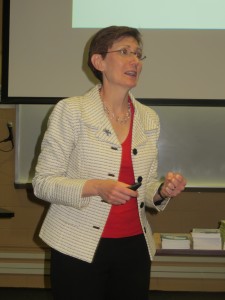
Dr. Jane Thierfield Brown speaks during a lecture last week at Westfield State University titled “Preparing for and Transitioning to College for Students on the Autism Spectrum.” (Photo by Hope E. Tremblay)
WESTFIELD – Preparing for college is a daunting task for any student and family, but add Autism Spectrum Disorder (ASD) into the equation and it can become even more overwhelming.
Dr. Jane Thierfield Brown gave a lecture last week at Westfield State University titled “Preparing for and Transitioning to College for Students on the Autism Spectrum” and told parents from the get-go that they may not be happy with what she was about to say.
What Brown said was that parents needed to help prepare their children for the transition while at the same time, backing away from micro-managing the student.
“The big question for students on the spectrum is who does the driving?” said Brown. “In middle school and high school, it’s the parents. In college, it’s the students.”
The Banacos Academic Center hosted the free public lecture. Brown has worked in disability services in higher education for 35 years at the University of Rhode Island, Barnard College, Columbia University, and the University of Connecticut. She currently works as Director of Student Services at the University of Connecticut School of Law and as an Assistant Clinical Professor at Yale Medical School in the Yale Child Study Center.
Brown also told the audience of students, teachers, counselors, and parents that they need to gather documentation for college accommodations because Individual Education Plans (IEP) and 504 plans do not follow a student to college and it is up to the student to make any request for accommodations and disclose their diagnosis themselves.
“Students on the spectrum need a lot of the same things as neurotypical students, but they may need more time,” said Brown.
Brown said more often than not, students with ASD and neurotypical students have to prepare for the same things beyond high school, they just may need to prep in different ways.
“If your child’s IEP says they do their work at school and have no homework, it’s a bad idea,” said Brown, who noted that students in college are expected to do as much work or more outside the classroom as they do inside it.
Brown also noted that students should be able to manage their time, care for themselves, and be able to get themselves up, get ready, and be on time for class.
“So who still wakes their child up in the morning?” Brown asked. “You have to teach your kids how to wake themselves up.”
Brown said another way parents should begin giving up control is to allow their children to run IEP meetings so they can learn to disclose their disability to others and ask for what they need.
Knowing their strengths and weaknesses is key, said Brown, who also told parents that they need to let their child steer the post-high school decisions.
“We are not applying to college,” she said, “They are applying to college.”
For some parents, college seemed out of reach for their autistic child.
“Autism touches most of us and in varying ways,” said Sarah Lazare, director of the Banacos Academic Center. “Recently, I heard of a parent who never considered that her child could go to college because of being on the autism spectrum. This renewed my desire to create opportunities for families, and aspiring and current educators of students, elementary through post-secondary, to keep the college pathway more inclusive and open for students on the autism spectrum. Jane Thierfield Brown’s work demonstrates how students can be successful and how parents and educators can prepare and support students on their trajectory to college.”
Brown’s main research interests are students with Asperger’s Syndrome in higher education and students with disabilities in high-stakes graduate programs.
“Students on the autism spectrum are attending campuses in increasing numbers, adding diversity and richness to universities and also bringing some challenges to the classrooms and residence halls,” said Brown.
She consults at many higher education institutions and is a frequent keynote speaker at conferences on Asperger’s Syndrome. She has co-authored three books on the subject: “Social Behavior and Self-Management: 5-Point Scales for Adolescents and Adults,” “The Parent’s Guide To College For Students On The Autism Spectrum,” and “Students with Asperger Syndrome: A Guide for College Personnel.” Dr. Brown has three children, the youngest of whom is a 20-year-old son on the spectrum.

